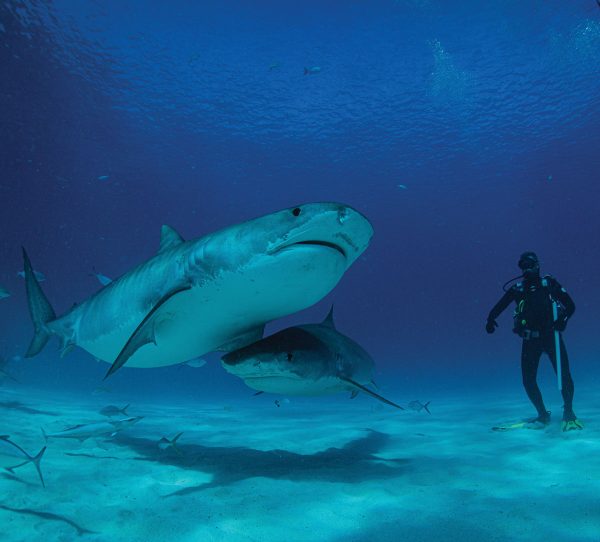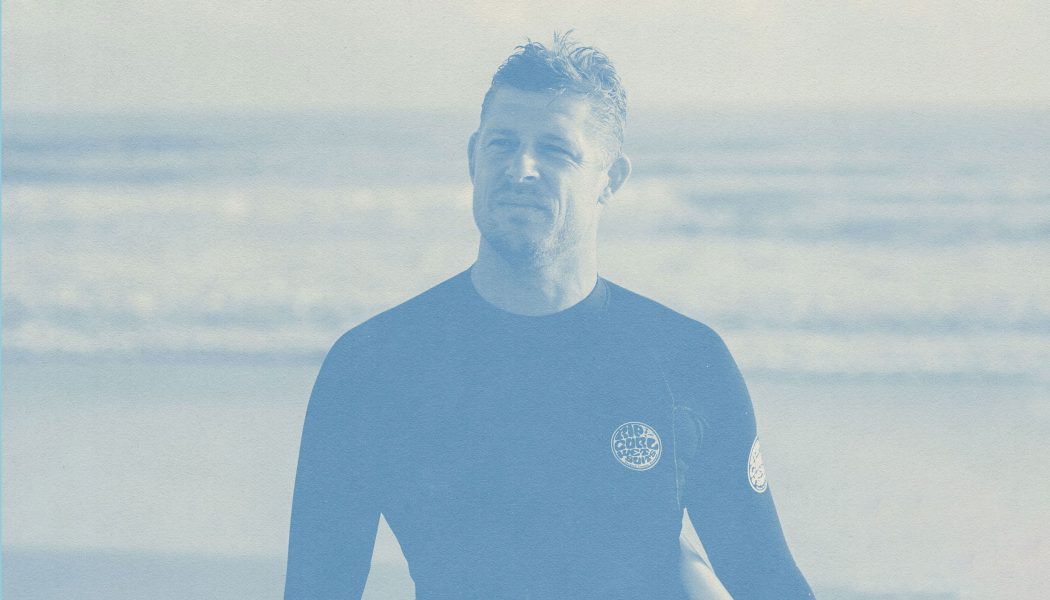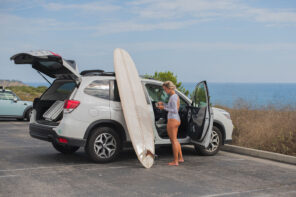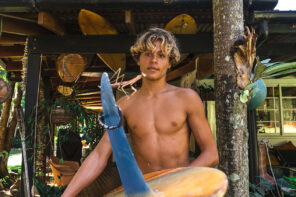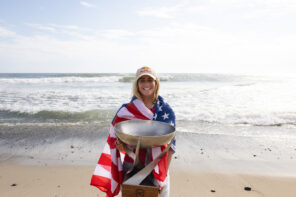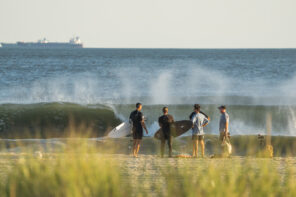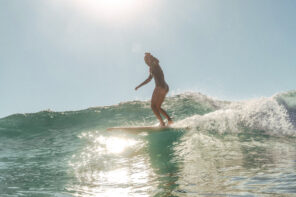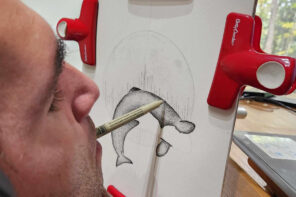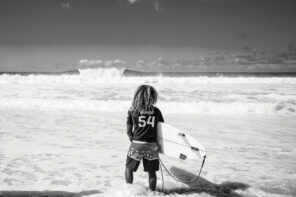Mick Fanning has surfed for 35 years and been a top pro for a great many of them. But for a lot of people, it’s an encounter with a shark that now defines him. Researcher and shark expert Cristina Zenato talks him through it.
@mfanno x @cristinazenato
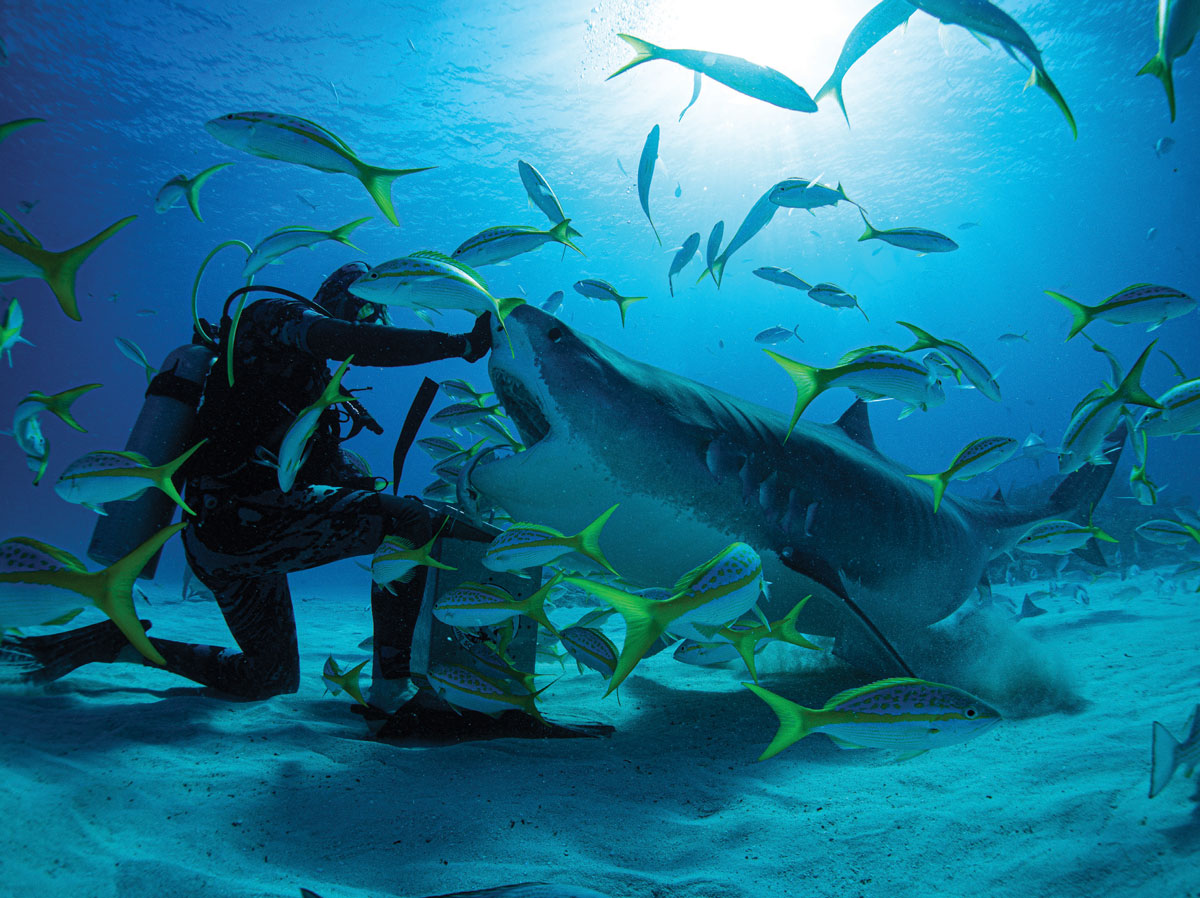
In a bit of live video too delicious not to stick to the ribs in a post-reality-TV-world, when a great white approached Fanning as he bobbed in the water during the opening minutes of the J-Bay Open 2015 finals at Jeffreys Bay, South Africa, the moment caused a sensation. And, at first at least, it continued to feed the misunderstanding of the relationship between humans and sharks. Turns out, that particular great white, caught in the surfer’s leash, might have been as frightened as Fanning.
But that video could also be a moment to trade fear for understanding and dive deeper into our relationship with those denizens of the deep. Filmmaker Taylor Steele’s documentary series Save This Shark, produced with National Geographic, takes Fanning’s encounter as a jumping off point in learning how we can coexist with our fellow apex predator.
During the filming, Fanning met conservationist, researcher and shark expert Cristina Zenato, who has been diving with, studying and advocating for sharks for more than 20 years from her adopted home of The Bahamas and abroad. She is not for nothing called “Mother of Sharks.”
Mick and Cristina watched the video clip of him at J-Bay and they walked through what happened leading up to it, what the shark may have been thinking, what that splash was and, crucially, what Fanning did in the days, weeks and now years after.
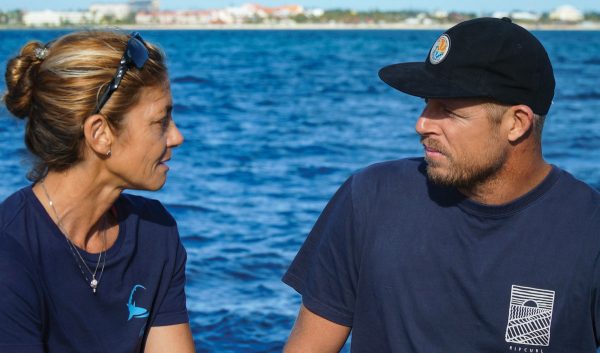
Cristina & Mick while Filming “Save This Shark”
Cristina Zenato: How many times have you been asked to look at the video?
Mick Fanning: Personally I’ve looked at it probably maybe 20 or 30 times and really tried to detail it out. Then, on top of that, every highlight of me or every little thing always goes back to that footage, but I don’t look at it in depth. It is sort of like it just happened.
Cristina: The question that I have for you, because I too receive a lot of questions about sharks, is: What attracts people to you through what happened and what do they want to know?
Mick: Yeah, look, it’s funny, you get a range of questions. First one, from little kids: “Was it scary?” Well, obviously, yes, and then some people are like, “You punched the shark.” And I’m like, “Well, not exactly.” I was just trying to get away and that was just the way I was trying to get away. When people say, “Oh, you punched it in the nose.” I wasn’t anywhere near the nose. All I saw was the dorsal fin and just girth and then the tail came and smacked me in the head from behind. And then you get some people that they might be conspiracy theorists where they will sit there and say, “Well, do you think it was trying to attack you or was it just swimming along and got stuck in your leg rope?” And, and I’m like, No, it came at me, but it was coming for my board. It wasn’t coming for me. There’s a point where it actually—I was off my board and my board was a few feet away and it bounced me and then went for the board. So that’s why I am like, no, it went for the board and not me.
Cristina: Yeah, that was my impression. That the shark just basically went for you and then at the last minute, it was just like, Oh, that’s not what I expected it to be, and almost bailed out on the decision. That is my point of view, but obviously I only saw the video.
Mick: To give you a bit of background, I was sitting there for probably about five minutes, just in the one spot, waiting for a wave.
Cristina: And your legs were in the water?
Mick: Yeah. Pretty much exactly how you see me right there, and then I think I’m going to get up and move down the point a little bit and then I heard it all happen behind me and I was like, Oh shit. So yeah, at that point, I’d been sitting there for five minutes, pretty much stationary. There was another guy in the water who caught a wave and he was probably 150 meters down the point and I was going to start heading down toward him, but then jet skis and boats were anywhere between 300 to 500 meters down the point. So I was pretty much by myself.
Cristina: Sitting there? Motionless?
Mick: Yes.
Cristina: Maybe, yes, the shark was like—and this is the “cleaner” mentality—Oh, there’s just something floating in the water motionless. Doesn’t give any signs of movement or anything like that. And it came up and then it was like, Well, that’s not what I thought it was. That’s what I thought from the video. I remember all I saw was the dorsal fin and just there’s part of the shark next to you, but I never saw the head or the pointy nose coming out.
Mick: No, no, that was the thing. I think it sort of looked at me. What we’ve seen now since that’s happened—there are so many drones and so many cameras on the surface in the lineup—is that they swim up the point. So it would have swam past everything, the boats, the other surfer, and I was the last thing there. And to me it looks like it was sort of cruising along and then all of a sudden just went, Oh, I’ll check this out real quick. And then that’s when it got stuck in my leg rope and freaked out—
Cristina: And panicked.
Mick: Yeah.
Cristina: There’s very old footage before the drone-time from South Africa that I had the opportunity to look at. A film crew was trying to get the shark to actually breach into a surfboard and they were trying to film it from the traditional below-the-surfboard type of work. And they ended up with a ton of footage of the shark going for the surfboard and every time, doing this same thing. So it swims along and it’s just, Oh, a surfboard. And he almost puts on the brakes as he hits the surfboard. So it took them a lot of attempts to actually get the footage in which the shark came in and just basically pushes the surfboard off the surface.
Mick: Yeah? Wow.
Cristina: So it was a unique thing to watch. Obviously, that footage was never shown. It only shows the surfboard getting hit, but it was a unique experience for me to sit there and look at that and look at how many times that shark went and changed its mind and its decision.
Mick: Yeah. Look, I feel like, you’ve probably got more expertise in this realm, but for how many surfers that are actually in the water—Look how many swimmers are in the water and we may only get around 10 attacks a year. It should be more with how many people are now in the water. So that explains a lot to me.
Cristina: Totally in agreement. If people compare the Bahamas, it’s a swimming nation, right? Our tourism is based around snorkeling, scuba diving, paddleboarding, kayaking and all of that and we are a shark diving capital of the world.
So we feed tigers, lemons, bull sharks, Caribbean reef sharks, oceanic white tips, and if you look at the number of people that go in the water with or without sharks, but we have sharks in our water and the number of incidents that we have in just the last 30 years that I’ve been here is absolutely inconsequential, and it’s a couple of people that I know for sure.
That does not include, obviously, spearfishermen. That’s a different ballgame because they’re attracting live fish. But when you say the people are in the water and the sharks come in and you don’t really understand, we don’t understand what the trigger is. Though the percentages of that are very, very minimal. So I do believe that for the most part, they’ll swim underneath and go, No, that’s not my interest.
Mick: There have been so many cases where people say, “Oh, we just saw a huge shark swim under you,” and it’s like, well, they don’t attack. And yeah, as I said, that one for me was just, I think it just made a decision to have a look and because I didn’t see teeth or anything like that at any point, I just saw the girth of it.
Cristina: They’re coming in at a speed, right? And as it broke its swim to avoid you, it hit you sideways, almost skidded off, if I can use that expression, on the water.
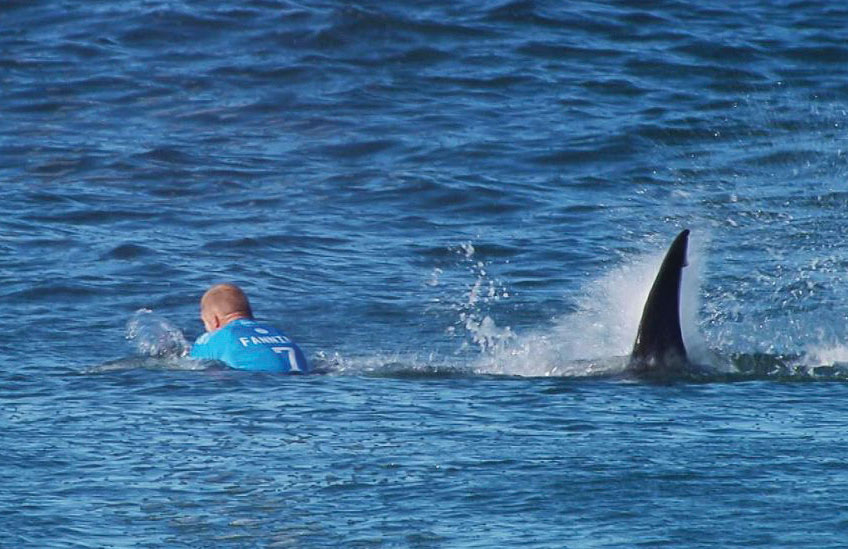
J-Bay Open 2015
Mick: It’s when I heard the splash, I tried to just get my board in between me and the shark. So I had some sort of barrier and that’s when I felt it in my leg rope. Because you’ll see, I look back over and I’m thinking, is it down there? And because it was in my leg rope, it was pulling me under and then it gave one big kick, that’s the one that hit me and snapped the leash and it did another loop.
And I totally thought it was totally freaked out, just frightened itself, and didn’t realize exactly what it was in, but I was so many feet away from my board and it came, brushed me and then the last thing I saw was just my board on top of its fin, just sailing off into the sunset. And I was like, I’m out, I’m swimming as far as I can.
Cristina: But even there, he went with a dorsal fin. So it’s almost like it was not intent on biting there either. If you think about it, right? Because otherwise, you would have seen the teeth coming out.
Mick: Yeah, you would have seen the teeth take out the board and I can’t speak for other people in their attacks, but it seems every time there is an attack or you know someone gets a board bitten or gets taken—it’s just one bite. It’s not a series of bites. If you see them even when you’re feeding them, they’re chomping. That’s how I see it, it could be different.
Cristina: Well, that is a little bit how the great white works. It usually comes in and gives a bite and then leaves it there to kind of bleed to death and then comes back and consumes when the animal is a little bit less combative. But it could also be that it gives it that bite and then there’s a different texture in their mouth.
Also, a lot of it is they become disturbed because a jet ski is coming and all of that. But with yours, I do believe that the shark bailed out on the decision, became entangled, panicked and tried just to get away from you. And then in the confusion was just like, Oh, what is that?
Mick: That’s seriously how I felt because it seriously could have hit me if it wanted to on that second run.
Cristina: Yes, you would not have heard the splash.
Mick: It felt like it hit me, I came down and then, and then it came back around.
Cristina: But at first you weren’t swimming, you were just–
Mick: No, I was there just like what, what just happened? And then I started swimming and that’s where you see the splashes in the thing and I’m kicking as hard as I possibly can to get out of there. But then I got to a point where I was like, Well, if this is going to take me, I’m going to have to turn around and fight. I’m not going down with just getting my legs taken or whatever. So I just stopped and tried to tread water and get as high as I possibly could so I could see it coming if it was going to come. Luckily it didn’t.
Cristina: Apparently being vertical in the water is a way of showing you aren’t prey.
Mick: Really? I didn’t know that. Cool.
The last thing I saw was just my board on top of its fin, just sailing off into the sunset.
Cristina: So usually when I receive these types of videos or requests, I try not to make up an opinion based on the small facts, but the moment when the dorsal fin and the tail came up and then you had the board in between, my thought was, Okay, he’s fine. The shark has realized that that is not what it is coming for.
Now, this is the first time that we have all the elements and you are the most important element, I didn’t even know you heard the splash.
Mick: Yeah, and a big thing for me after getting home and dealing with it all was going surfing again, after hearing that splash—like hearing a little wave or a fish jump or a friend splashing me, I would jump. I would freeze.
Cristina: There is one of your countrymen, he’s an amazing man. Rodney Fox. He’s very famous for having been literally taken by a great white while he was in a spearfishing competition and there’s a beautiful video that is maybe 30 years old. He talks about going back to the water. He will go up, back to the water and he says every time his knee basically hits a sponge or a soft spot, in his mind he thinks, Oh, here’s another shark, I just bumped into another shark.
You just said the same exact words. He told the story so many times and to so many people and people just wanted to hear how he punched a shark and how he stuffed his hand into his eye. And then as somebody turned around and said, “Well, no, that’s not really how it happened.” And he started telling the story to people who wanted to hear. It’s a beautiful journey.
Mick: It’s funny, people get this perception of sharks as just straight cold predators, killers and because that’s what the media sells. That’s what people want to hear.
That’s what Jaws was like, but we’re on this journey and learning so much more about them. To me, they just remind me of puppy dogs in a way where, or dogs, where they want that attention, but if you piss them off then they are going to bite.
Cristina: Yes, or they’ll bite for different reasons regardless of the attention that they want or not. I think to trigger a shark bite it takes like a very, very long time. It’s different from what people portray. Actually, as it says, “Shark Attacks Mick Fanning” and I feel like saying, “Well, no, it’s a shark gets entangled with Mick Fanning.”
Mick: Yeah, you can go on Wikipedia and change it if you want.
Cristina: But if you think about it, you guys just crossed paths.
Mick: Yeah, and that’s the reason why people always sit there and they ask, “Are you okay? Are you okay?” And I say, Yeah, I dealt with it. You know, and I sort of look at it as how many times do you walk across the street and nearly get hit by a car? It doesn’t cripple you from walking across the street. It’s like, okay, well, that happened for the first time in 35 years of being in the ocean. What are the chances of it happening again? Hopefully none for me, but yeah, that’s the way I look at it—it was an encounter and it’s time to move on.
Cristina: Totally in agreement. It’s just he’s going his own merry way and you are going on yours.
Mick: Yeah, he’s on the train to Cape Town. I got on a plane to Australia.
Cristina: So let’s put it in perspective. Mick Fanning has been out there for 35 years. An average of two to eight hours a day, so your average is four and a half hours a day, almost every day. And that was your first encounter and that one in a certain way brought you more attention than your 35 years of surfing—and not to take anything away from you, but that is the issue, right? So we have one shark, one encounter and you receive all this attention, but nobody puts it in perspective: World champion Mick Fanning has been out there surfing for 35 years, four or five hours a day, first encounter.
Mick: There are so many elements that go into why we’re seeing so many more sharks. I’m not fully up on the statistics, but are there more attacks or not? But we’re seeing more because there are more eyes on the water, there are more people in the water. So that was a big thing for me when this happened. Trying to figure out why we are seeing them more or why are these encounters happening or attacks happening in these areas, and I couldn’t get any information.
Cristina: You’re trying to figure it out. I think you have to put in both components. It’s not just why the sharks are here, why are there more sharks, or why are the sharks coming closer? But what are we doing as humans that we didn’t do before? Are there more sharks in one place because in another area there’s no more food? Are there more sharks in the area because we actually have made it impossible for them to be somewhere else? Or have we made an area more attractive?
So I think it is analyzing the sharks behavior, but we also need to analyze human behavior. Some people don’t want to hear that it could be human-caused, and is it the warming of the ocean, is it ocean acidification—are these all factors that change how these creatures are moving around the ocean? Not only the sharks at this point, maybe even fish or invertebrates. And we don’t really pay attention to it. So we pay attention to the sharks because obviously, I want to go to the beach. But now there are 20 great whites patrolling the beach. It’s like, Oh, I can’t go anymore. Then maybe there are 2,000 more sea cucumbers in the sea than before. It just doesn’t affect us. And I think if you really want to look at it, it’s not just why are the sharks here? But what have we done that may have changed that relationship? Or what may have happened in the world that changed that relationship?
Mick: Yeah, get that whole 360-view rather than say, “Okay, there are lots of sharks here, let’s start culling.” That’s the worst thing ever. It doesn’t solve anything.
Cristina: It does not solve anything. Killing sharks to make the ocean safer is not going to do that. What it is going to do is actually make the ocean unhealthier and it is unfortunate that maybe as humans, one day we might have to come to say, “You know what? This bay should be off-limits.”
Maybe that has become a favorite place for great whites and so now you increase your chances of that encounter. So you might have to move a couple of miles and it’s hard for humans to accept that. Maybe that is a part of the process that we need to do. As an example, I’m very comfortable swimming here. Scuba diving and going cave diving. There’s a cave that I go dive in. The Ocean Blue Hole. So I have to wade about 500 meters from shore to get to this hole to go in it. And I’ve been there a couple of times where the water was completely milky white from the previous storm. And I’m looking at the ocean and I start going in and I look down and I can’t see my feet.
Now I’m dressed in all this cave gear with metal rings and metal reels and everything’s going cling, clang, ding, ding, ding and I can’t see past my knee, and we are in a tiger shark area. I know they patrol that area. I simply get out of the water, because if I can’t see from my knee down to my ankle, that is how close a shark might have to get in order to figure out really, what is that movement and all those vibes that I’m sending out. The day that the water is clear I’m back there wading over to my cave without any issues.
So it is understanding how the shark behaves and adapting our behavior to them. And that even changes from day to day, from shark to shark, even within the same species. And I think as humans, this is one of the things that we owe, not only the ocean or the sharks but to this planet. We need to start understanding how they work so that we can connect or compromise a little bit more.
Mick: Follow your intuition a little bit. Yeah. Growing up, that was a big thing. You’d get this intuition that there might be a shark around. It was like, stop being soft. Stop being scared. Just go on with it. Where now it’s like, since the encounter, if I feel something and I don’t feel right, I just head back. I don’t have to prove that I’m tough or whatever. It’s just an intuition thing where I listen to that a lot more now than I did in the past.
Cristina: We do have instincts. We should not let fear overwhelm the instincts, but I think sometimes we need to listen to that and say, well today has really precarious conditions. I will just sit it out. The next day the conditions are way better. So we’re good to go.
